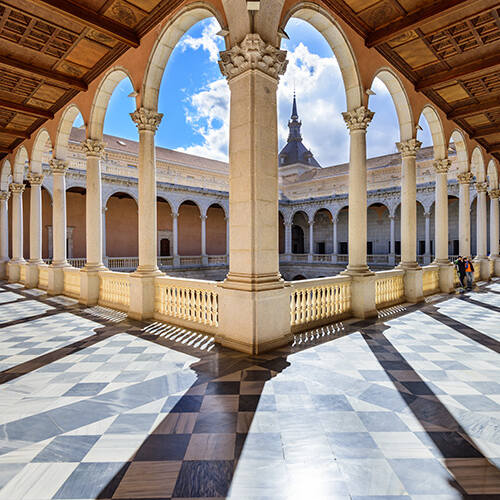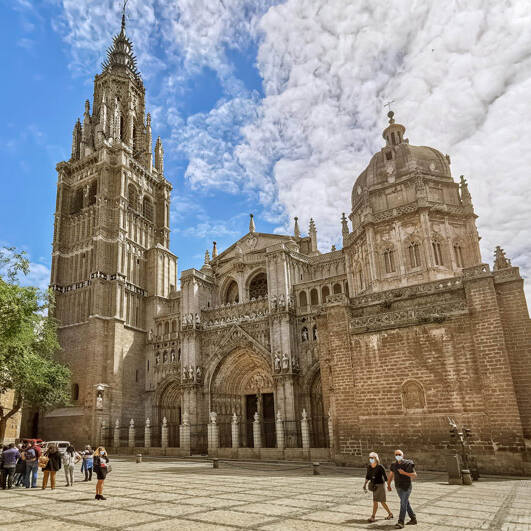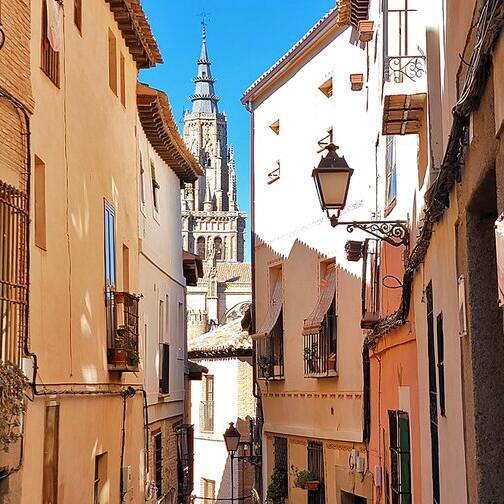Why visit Toledo?
The major reason to visit Toledo is the sheer amount of history and culture that you can experience here. As the ‘city of three cultures,’ there’s nowhere else in Spain where you can learn so much about the Christian, Muslim, and Jewish populations who lived together peacefully in Toledo. All of these peoples and cultures have left behind a diverse array of landmarks, from gothic churches to mosques and synagogues.
This treasure trove of historical architecture is also what gives the city its unique ambiance. The fusion between medieval mystique and modern-day Spain is a major draw for tourists coming to the country, and Toledo does it like nowhere else.
The cobbled historic core is seemingly trapped in time, offering a look at the Spain of old, leading you between quiet plazas and secretive laneways, while around every corner lies another church spire, a mosque dome, or synagogal tiles. There’s a certain sense of wonder that a visit to Toledo brings with it, and all this can be found just a half hour from the buzzing capital, Madrid.
Toledo is also famous for its Damascene metalwork, and you’ll be able to visit sword shops across the city and learn about how the metal was shaped into armor and weapons back in the day. Then there’s the city’s relationship with marzipan, which you’ll find dominate the sweet shops scattered throughout the city streets. And finally, Toledo is a hub of all things El Greco, the famous Greek painter who was a master of the Spanish Renaissance art movement.
Add it all up and you’ve got a beautiful city where you can easily garner an understanding of the different cultures that have influenced Spain throughout its history. And if that doesn’t interest you, the timeless atmosphere and stunning old town alone promise an unforgettable trip.
What to see and do
1. Explore Toledo’s old town
Toledo’s Old Town, a UNESCO World Heritage Site, is a labyrinth of narrow cobbled streets that transport you back in time. As you wander through the winding alleys, you’ll encounter stunning examples of medieval, Renaissance, and Mudéjar architecture at every turn.
The city’s historic center is jam-packed with the city’s most important historical landmarks, including the iconic Cathedral, the imposing Alcázar, and the Monasterio de San Juan de los Reyes, all of which you’ll find listed below.
But simply wandering through the twists and turns, emerging in quiet plazas and through secretive alleyways, is one of the best things to do in Toledo.
2. Cathedral of Toledo
The Cathedral of Toledo is the most important attraction in the city. This grand monument is a masterpiece of medieval Gothic architecture, taking over 200 years to complete after construction began in the 13th century.
The interior is simply awe-inspiring, with soaring Gothic arches, intricate stained-glass windows, richly adorned chapels, and a staggering number of artworks.
You can jump on a guided tour which will take you up the tower for panoramic views of Toledo.
3. Synagogue of El Tránsito
The Synagogue of El Tránsito was built in 1355 and is Toledo’s most magnificent synagogue. This piece of Jewish history is now home to the Museo Sefardí, providing a rare glimpse into the culture and history of Sephardic Jews in Spain.
Inside, the beautifully preserved prayer hall features Mudéjar tiling and Hebrew carvings.
4. Climb up to Toledo’s Alcázar & the Museo del Ejército
Nestled atop Toledo’s highest point, the imposing Alcázar fortress stands as a testament to the city’s tumultuous past and rich military heritage. Originally constructed by Abd ar-Rahman III in the 10th century, the fortress has undergone numerous renovations, with its most recent reconstruction occurring during Franco’s era.
Today, it serves as an expansive military museum (Museo del Ejército), housing a wealth of artifacts that chronicle centuries of warfare and conflict.
5. Museo del Greco
Toledo is closely associated with the renowned artist El Greco, and while you’ll find his works scattered in different attractions across the city, the largest collection of his works can be found at the Museo del Greco (the name might have given it away).
The museum is inside the former home of a local aristocrat, a beautiful piece of architecture that’s the perfect backdrop to some of El Greco’s most well-known masterpieces. Also on show are works by other artists to let you know that it wasn’t just El Greco who found inspiration in the beauty of Toledo.
6. See exquisite architecture at Monasterio de San Juan de los Reyes
In the heart of Toledo’s Jewish Quarter stands the Monasterio de San Juan de los Reyes, constructed during the reign of Isabella I of Castile, one of Spain’s most influential queens. This Franciscan monastery was intended to serve as a royal mausoleum, although they ended up being buried in Granada instead. Regardless, the architecture is a fantastic look at the Isabelline style, characterized by its elongated structure and numerous side chapels.
The monastery’s crowning jewel is its remarkable two-level cloister, a blend of Gothic and Mudéjar influences and adorned with exquisite statuary, arches, vaulting, and elaborate pinnacles, all surrounding a lush garden.
7. Learn about the city’s history at Museo de los Concilios y la Cultura Visigoda
The Visigoths also had their time in Toledo, and you can explore this often-overlooked part of the city’s (and all of Spain’s) history at the Museo de los Concilios y la Cultura Visigoda.
Sometimes dubbed the ‘Invisigoths’ due to the scarcity of records about their time in Spain, the museum provides a nice opportunity to learn about this civilization and their time on the Iberian peninsula. Moreover, Toledo is one of the few places in the country where you can really feel their presence; the city was their de facto capital during the 6th and 7th centuries.
Housed within the 13th-century San Román church, this modest museum offers a glimpse into this period, with artefacts, Mudéjar-style architecture, and frescoes.
8. Iglesia de Santo Tomé
The Iglesia de Santo Tomé is a historic church renowned for housing one of El Greco’s most famous paintings, El Entierro del Conde de Orgaz (The Burial of the Count of Orgaz), which is considered a masterpiece of Spanish Renaissance art.
The church itself was founded after Toledo’s reconquest and stands on the site of a former mosque.
9. Santa Cruz Museum
Housed in a former hospital, the Museo de Santa Cruz offers a diverse collection of works, which includes El Greco’s famous painting Sagrada Familia con Santa Ana (The Holy Family with Saint Anne), modern sculptures, medieval furniture, and Roman artifacts.
It’s a bit of an eclectic collection that combines art, history, and archaeology.
10. Stroll along Puente de San Martín
The Puente de San Martín is a medieval bridge that spans the River Tagus, and a nice spot to take a stroll. As you walk across, you’ll be treated to great views of the old town, as well as the rushing river below.
Legend has it that the wife of the bridge’s architect saved it from collapse by burning the scaffolding during a thunderstorm.
11. Convento de Santo Domingo El Antiguo
Tucked away in Toledo’s winding streets, the Convento de Santo Domingo El Antiguo is one of Toledo’s lesser-known spots. This 11th-century monastery is home to one of El Greco’s earliest works, El tránsito de la Virgen (The Assumption of the Virgin), but beyond that it’s simply a beautiful place to escape the busy streets and relax in a peaceful and historic building. Small, beautiful, and quiet.
12. Catch the views at Mirador del Valle
For unparalleled views of Toledo, either drive or make the 30-minute walk up to Mirador del Valle, an exquisite viewpoint offering sweeping panoramas of the entire city.
Situated on the opposite side of the Río Tajo south of the city, this strategic vantage point showcases magnificent vistas of the river, the iconic Alcázar, and the labyrinthine of city streets.
13. Enjoy Toledo’s culinary delights
Toledo’s traditional cuisine is a testament to its rich history. The city’s most famous dish is the suckling pig, which is slow roasted to perfection and served with crispy skin. Other regional specialties include venison stew, partridge, and migas (a dish made with breadcrumbs, garlic, and spices).
Toledo is also renowned for its marzipan, a sweet treat made from almonds and sugar. The city has a long-standing tradition of marzipan production, with numerous pastry shops offering a variety of flavors and shapes.
14. See the tapestries at Museo de Tapices y Textiles de la Catedral
Set in the former 17th-century school for choirboys, the Museo de Tapices y Textiles de la Catedral houses a magnificent collection of tapestries. These woven masterpieces feature intricate designs and brilliant colors, and depict biblical scenes and historical events.
The museum provides a fascinating glimpse into the art of tapestry-making, which is a significant part of Toledo’s cultural heritage.







